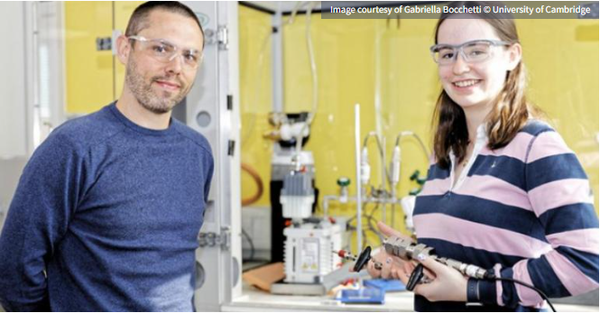University of Cambridge professor Israel Temprano and PhD chemistry student Grace Mapstone are working on a project to create supercapacitors that can capture carbon dioxide from natural materials. The two co-authored a paper published in the journal Nanoscale.
The researchers hope that this low-cost, environmentally friendly device can eventually be scaled up to participate in larger-scale greenhouse gas harvesting efforts.
Researchers say they have developed a low-cost battery-like device from some natural materials that can be environmentally friendly by harvesting carbon dioxide from the air.
The team at the University of Cambridge built the supercapacitor, which the researchers say is about a penny in size and can selectively capture carbon dioxide gas as it charges. The gas can be released during a controlled discharge, or collected for reuse or safe disposal.
The researchers said they made the capacitors more sustainable by including natural materials such as coconut shells and seawater as part of the battery design.
"We wanted to use inert materials that would not harm the environment and would also reduce the frequency of handling. For example, carbon dioxide can be dissolved in a in the water-based electrolyte of seawater.

Advantages of supercapacitors
A supercapacitor is similar to a battery in that it stores and discharges energy, but usually has a smaller capacity than a typical battery.
However, the advantages of these supercapacitors rely on the movement of electrons, rather than chemical reactions, which can lead to longer lifetimes and slower degradation rates.
Mapstone notes that this will help researchers develop an energy storage device that can participate in carbon capture through low-cost, readily available materials.
She also said in the interview: "For materials like carbon capture, we prioritize durability. Best of all, the materials used to make supercapacitors are cheap and plentiful. The electrodes are made of carbon, which can be sourced from waste. coconut shell.
how the system works
Similar to a battery, a supercapacitor consists of two electrodes, one with a positive charge and the other with a negative charge. To extend the charging time of their predecessor devices so that they could capture more carbon, the researchers experimented with alternating charging from negative to positive voltages, led by researcher Trevor Binford, who was studying at Cambridge University at the time Master's degree.
Alexander Forse, professor in Cambridge's Yusuf Hamied Department of Chemistry, who led the entire project, said: "We found that by slowly changing the current between the two electrodes, double the amount of carbon dioxide can be captured. "
A supercapacitor, however, cannot spontaneously absorb carbon dioxide; it does so only while charging, the researchers say. The process works like this: As the electrodes are charged, the negative electrode absorbs carbon dioxide gas while ignoring other emissions such as oxygen, nitrogen and water. In this way, they say, supercapacitors can both capture carbon and store energy.
Scalable future
The researchers published their research paper in Nanoscale.
The research team hopes that supercapacitors can be prototypes for large-scale devices that could capture some of the nearly 35 billion tons of carbon dioxide released into the atmosphere each year.
In fact, this is a good start, Forse said, and the supercapacitor charging and discharging process may consume less energy than the amine heating process currently used in industry to harvest greenhouse gases.
Forse added: "The next area of research will involve sophisticated devices for capturing carbon and how to improve them. It will be a question of scaling up."

